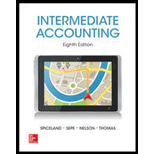
Concept explainers
(1)
Receivables:
Receivables refer to an amount to be received in future. General classifications of receivables are
To prepare:
(1)
Explanation of Solution
March 17: Write-off of account receivables:
| Date | Account Title and Explanation | Post Ref |
Debit ($) |
Credit ($) |
| March 17, 2016 | Allowance for uncollectible accounts | 1,700 | ||
| Accounts Receivable | 1,700 | |||
| (To record the write-off of receivables) |
Table (1)
March 30: Receipt of Notes Receivable:
| Date | Account Title and Explanation | Post Ref |
Debit ($) |
Credit ($) |
| March 30, 2016 | Notes Receivable | 20,000 | ||
| Cash | 20,000 | |||
| (To record receipt of notes receivable) |
Table (2)
May 30: Discounting of Notes Receivable:
- Accrual of Interest:
| Date | Accounts title and explanation | Post Ref. |
Debit ($) |
Credit ($) |
| May 30, 2016 | Interest Receivable | 233 | ||
| Interest revenue (1) | 233 | |||
| (To record accrued interest) |
Table (3)
- To record the loss:
| Date | Account Title and Explanation |
Post Ref. |
Debit ($) | Credit ($) |
| May 30, 2016 | Cash (5) | 19,973 | ||
| Loss on Sale of Note Receivable (Refer table 5) | 260 | |||
| Notes Receivable | 20,000 | |||
| Interest Receivable (1) | 233 | |||
| (To record the discounting of note receivable) |
Table (4)
Working note:
Compute the amount of interest accrued:
Principal = $20,000
Rate of interest = 7%
Period = 2 Months (March 30 to May 30)
Compute the amount of interest on maturity:
Principal = $20,000
Rate of interest = 7%
Period = 12 Months (March 30, 2016 to March 30, 2015)
Compute the maturity value:
Compute the amount discount on discounting the note:
Compute the amount of cash proceeds:
Compute the loss on sale of notes receivable:
| Face value of Notes Receivable | $20,000 |
| Add: Interest Receivable | 233 |
| Less: Cash Proceeds | (19,973) |
| Loss on Sale of Investments | $260 |
Table (4)
June 30: Sales:
| Date | Account Title and Explanation |
Post Ref. |
Debit ($) |
Credit ($) |
| June 30, 2016 | Accounts Receivable | 12,000 | ||
| Sales Revenue | 12,000 | |||
| (To record the sales on account) |
Table (5)
July 8: Collection from Customers:
| Date | Account Title and Explanation |
Post Ref. |
Debit ($) |
Credit ($) |
| July 8, 2016 | Cash (7) | 11,760 | ||
| Sales Discount (6) | 240 | |||
| Accounts Receivable | 12,000 | |||
| (To record the sales remittance) |
Table (6)
Working note:
Compute the amount of discount:
The sale was made on June 30 and the payment is received on July 8. Hence, the customer is eligible for a sales discount of 2% (2/10 term).
Compute the amount of cash received from the customer:
August 31: Sale of Stock:
| Date | Account Title and Explanation |
Post Ref. |
Debit ($) | Credit ($) |
| August 31, 2016 | Notes Receivable | 6,000 | ||
| Discount on Note Receivable (8) | 240 | |||
| Investments | 5,000 | |||
| Gain on Sale of Investments | 760 | |||
| (To record the exchange of notes receivable with stock) |
Table (7)
Working note:
Compute the discount on notes receivable:
Compute the gain on sale of investments:
| Face value of Notes Receivable | $6,000 |
| Less: Book value of investment | (5,000) |
| Less: Discount on Note receivable | (240) |
| Loss on Sale of Investments | $760 |
Table (8)
December 31, 2016:
| Date | Account Title and Explanation | Post Ref |
Debit ($) |
Credit ($) |
| December 31, 2016 | Bad Debts Expense (9) | 14,000 | ||
| Allowance for uncollectible accounts | 14,000 | |||
| (To record the |
Table (9)
Working note:
Compute the amount of bad debts expense:
To prepare: necessary
Explanation of Solution
December 31, 2016: Adjusting Entry for Interest Accrual:
| Date | Accounts title and explanation | Post Ref. |
Debit ($) |
Credit ($) |
| December 31, 2016 | Discount on Note Receivable | 160 | ||
| Interest revenue (10) | 160 | |||
| (To record accrued interest) |
Table (10)
Working note:
Compute the amount of interest:
Principal = $6,000
Rate of interest = 8%
Period = 4 Months (August 31 to December 31)
Want to see more full solutions like this?
Chapter 7 Solutions
INTERMEDIATE ACCOUNTING
- If the company uses full costing, the ending inventory for the year would be valued at ______.arrow_forwardAlicia Logistics purchased a conveyor belt system for its distribution center at a cost of $105,800. The system has an estimated residual value of $8,600 and an estimated useful life of 12 years. What is the amount of the annual depreciation computed by the straight-line method?arrow_forwardI am looking for help with this general accounting question using proper accounting standards.arrow_forward

 AccountingAccountingISBN:9781337272094Author:WARREN, Carl S., Reeve, James M., Duchac, Jonathan E.Publisher:Cengage Learning,
AccountingAccountingISBN:9781337272094Author:WARREN, Carl S., Reeve, James M., Duchac, Jonathan E.Publisher:Cengage Learning, Accounting Information SystemsAccountingISBN:9781337619202Author:Hall, James A.Publisher:Cengage Learning,
Accounting Information SystemsAccountingISBN:9781337619202Author:Hall, James A.Publisher:Cengage Learning, Horngren's Cost Accounting: A Managerial Emphasis...AccountingISBN:9780134475585Author:Srikant M. Datar, Madhav V. RajanPublisher:PEARSON
Horngren's Cost Accounting: A Managerial Emphasis...AccountingISBN:9780134475585Author:Srikant M. Datar, Madhav V. RajanPublisher:PEARSON Intermediate AccountingAccountingISBN:9781259722660Author:J. David Spiceland, Mark W. Nelson, Wayne M ThomasPublisher:McGraw-Hill Education
Intermediate AccountingAccountingISBN:9781259722660Author:J. David Spiceland, Mark W. Nelson, Wayne M ThomasPublisher:McGraw-Hill Education Financial and Managerial AccountingAccountingISBN:9781259726705Author:John J Wild, Ken W. Shaw, Barbara Chiappetta Fundamental Accounting PrinciplesPublisher:McGraw-Hill Education
Financial and Managerial AccountingAccountingISBN:9781259726705Author:John J Wild, Ken W. Shaw, Barbara Chiappetta Fundamental Accounting PrinciplesPublisher:McGraw-Hill Education





